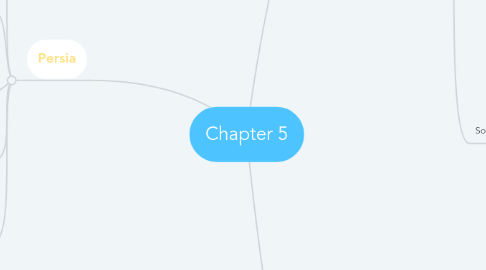
1. Persia
1.1. Culture
1.1.1. Celebrated Mesopotamian culture; had own artistic traditions
1.1.2. Main religion was Zoroastrianism, but tolerated many religions.
1.2. Human-Environment
1.2.1. Empire developed near old Mesopotamia and contained many deserts and inhospitable places.
1.2.2. Built roads across empire
1.2.3. Spread over a vast amount of land; took 90 days to travel across
1.3. Economic Factors
1.3.1. Traded with parts of Asia, Africa, and the Mediterranean.
1.4. Political Structures
1.4.1. Government was ruled by a king; governors ruled smaller areas
1.4.2. Believed in strong central power; highly centralized; Cyrus the Great was the first leader
1.5. Social Structures
1.5.1. Social hierarchy where kings were at the top and priests were also high up
1.5.2. Used slaves
2. Rome
2.1. Culture
2.1.1. Celebrated conquest and the glories of battle
2.1.2. Spoke Latin, had a polytheistic religion based off of Greece, and were tolerant to some, but not all, religions
2.1.3. Women had great de facto power, but little under the law
2.1.4. Converted to Christianity under Constantine shortly before the end of the Western Roman Empire
2.1.5. Thought education, philosophy, and engineering were important
2.1.6. Had a focus on engineering
2.1.7. Art was focused on human condition
2.2. Human-Environment
2.2.1. Burning of wood polluted environment
2.2.2. Water was transported through aqueducts
2.3. Economic Factors
2.3.1. Economy was largely based on conquest and slaves
2.3.2. Traded within itself and also with China and others
2.4. Political Structues
2.4.1. The republic was controlled by the senate and 2 consuls
2.4.2. Was originally a monarchy, then a republic, and finally an empire
2.4.3. The Empire was controlled by an Emperor; all ethnicities could become citizen or emperor
2.4.4. Political power was derived from military power
2.4.5. Had codified laws, citizenship, and standards across the empire
2.4.6. Strong local power; citizenship for certain people
2.5. Social Structures
2.5.1. Very divided groups: slaves, plebeians, patricians
2.5.2. Status could be gained from conquest
2.5.3. Women had no rights
3. Greece
3.1. Culture
3.1.1. Literary focus on tragedies and comedies
3.1.2. Influenced by Egyptians
3.1.3. Big focus on art and sculpture
3.1.4. Olympics brought all states together
3.1.5. Spoke a language derived from Phoenician alphabet
3.1.6. Hellenistic-Greek and Middle Eastern culture merged
3.1.7. Had a focus on seafaring
3.2. Human-Environment
3.2.1. Mountainous regions prevented any one nation from controlling it all; affected political structure
3.3. Economic Factors
3.3.1. Slaves were traded
3.3.2. Desire for money from conquest led to Peloponnesian war
3.4. Political Structures
3.4.1. Strong city-states ruled certain areas; Athens and Sparta were the strongest
3.4.2. Direct democracy was used in Athens, and certain positions were chosen randomly
3.4.3. Sparta used strong leaders in place of democracy
3.5. After Alexander the Great's death, the newly united empire fractured into small regional governments
3.6. Pericles was important Athenian adviser; tried to prevent Peloponnesian wars
3.7. Social Structures
3.7.1. Slaves were used in both Athens and Sparta; more so in Sparta
3.7.2. Athens decreed anyone should be prepared to serve in the government; positions were chosen by lot

